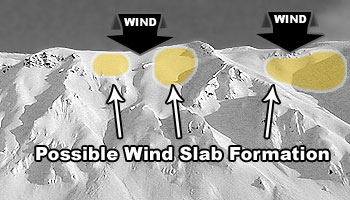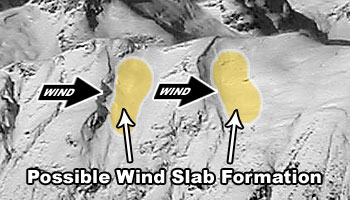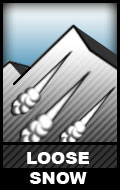Avalanche Danger Forecast
Issued Wednesday, December 23, 2020 at 10pm for the greater Anchorage area Western Chugach Mountains (i.e. Chugach State Park):
Avalanche danger is expected to remain at moderate through this forecast, although it will fluctuate within the moderate spectrum.
Increasing danger is expected through Thursday due to winds potentially being strong enough to wind load leeward terrain with the few to several inches of loose snow available for transport from Tuesday-Wednesday snowfall. Avalanche danger could increase to near considerable
Decreasing danger is expected Friday due to relatively clear and calm conditions.
Danger is expected to continue decreasing Saturday if there is no significant wind or precipitation.
__________
The mountains are adjusting to significant stress from the Tuesday-Wednesday storm. That storm brought a few to several inches of snow and many hours of strong winds to the mid and upper elevations of Chugach State Park, and initiated a widespread natural avalanche cycle with many paths producing D2 avalanches.
The last hours of the storm deposited lower-density snow with relatively light winds.
Surface conditions were excellent powder on Wednesday, although red flags were present: recent natural avalanches and collapsing (“whumphing”).
Avalanche Problems:
Human triggered wind slabs up to D2 in size are possible above 2500′ on leeward terrain steeper than 35º through the forecast period. Wind slab danger is expected to be the highest Thursday afternoon, as strong winds may further load leeward terrain. Potentially dangerous wind slabs are most likely to exist below corniced areas and along the lee sides of ridges and cross-loaded features like gullies:
Active wind loading and shooting cracks are red flag indicators of wind slab danger. Hollow and/or punchy feeling snow (denser, wind-packed snow overlying looser and less cohesive snow) and pockets of deeper snow with a bulbous or fat appearance are further kinesthetic and visual indicators of potential wind slab danger.
Pole probing and hand pits are a quick and effective means of assessing this problem as you travel. Use pole probing to quickly feel out areas of denser, wind-packed snow overlying looser and weaker snow. Use hand pits to quickly assess how near-surface layers of snow are bonded.
Digging a snowpit and conducting a compression test and/or extended column test will provide an even better assessment of bonding and instability before you travel on terrain of consequence.
You can also assess wind slab instability via safer “test slopes” that are representative of higher consequence terrain.
Wind slabs triggered in big avalanche paths do have the potential to “step down” and trigger larger and more dangerous persistent slab avalanches.
Human triggered persistent slabs up to D2.5 in size are possible through the forecast period on all aspects above 2500′ where the terrain is steeper than 35º. Persistent slab danger is expected to be the highest on upper elevation leeward terrain Thursday afternoon, as wind loading will add stress and make these slabs more reactive to human triggers. While lower probability than wind slabs, persistent slabs are relatively unpredictable and have the potential to be high consequence (due to hard slab characteristics).
Diverse and widespread persistent weak layers exist in the snowpack. Faceted snow exists above and below crusts in some areas, sandwiched between wind packed layers in many areas, and a basal weak layer of advanced facets and depth hoar is widespread.
On Wednesday, collapsing was a red flag warning of persistent slab danger. Be mindful of further collapsing (aka “whumphing“) and shooting cracks as continuing indicators of this danger.
Without red flags, which will become less likely with time, understanding how this problem is manifesting where you intend to travel will require digging a snowpit, conducting instability tests, and analyzing snowpack stratigraphy.
Terrain management is simply the best way to avoid this avalanche problem: don’t expose yourself to terrain capable of producing a dangerous persistent slab.
Dry, loose snow avalanches are possible above 3000′ on steep (38º+) terrain across all aspects. These may be in the form of naturally triggered wind-induced spindrift or human triggered sluffs.
While these avalanches will be relatively small (D1), they do have the potential to cause a fall or loss of control and build up mass that “steps down” and triggers a larger slab avalanche.
Don’t let a small loose snow avalanche catch you off guard, especially if you’re on exposed terrain.
Before traveling on, through, or under terrain that has the potential to avalanche; think about the consequences and have a plan (to escape the avalanche, for re-grouping, and rescue).
Be mindful of terrains traps!
Poor visibility (due to cloudy skies and flat light) and short days increase the difficulty of mountain travel. The consequences of an accident are generally higher this time of year, and rescue efforts complicated by darkness.
Click the hyperlinks and icons to learn more.






